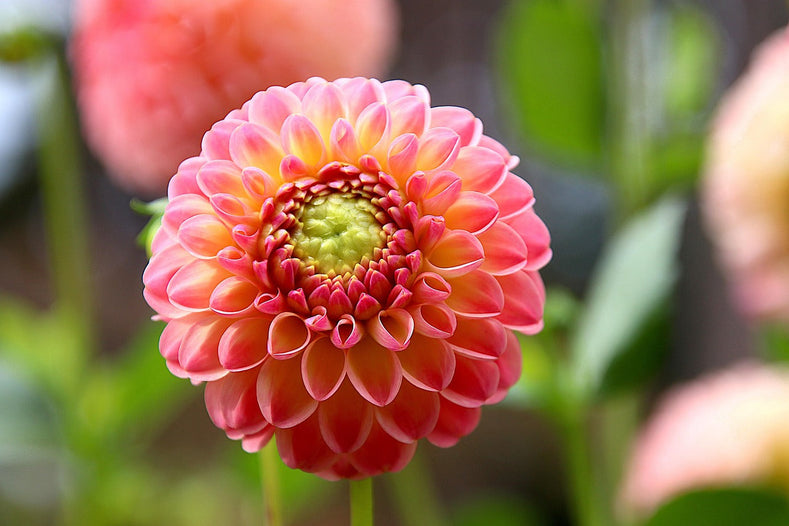How To Divide Dahlia Tubers?
Dahlias are true sun lovers, but they are very sensitive to frost. That’s why gardeners in the colder climates of the US dig up the Dahlia tubers and store them over the winter to protect the tubers and prepare them for the next growing season. When digging up, you can choose to split the Dahlias for new growth and keep them healthy for the next season. In this guide, we’ll explain how to divide Dahlia tubers.
Can You Divide Dahlias?
Dividing or “splitting” Dahlias is an effective way to propagate them. During their growing season, Dahlias produce tubers (or tuberous roots) that can be separated to create new plants. While Dahlias can also be grown from seed or cuttings, dividing the tubers is the quickest method to expand your collection.
Fun fact: Some Dahlias have long and skinny tubers, while others have short and large tubers.
What Happens If You Don't Divide Dahlia Tubers?
You can choose not to divide Dahlia tubers. However, it is possible that several problems may occur over time. For example, overcrowding can result in smaller blooms, weaker stems, and reduced overall plant health as the tubers compete for nutrients and space. Dividing Dahlias can have the following advantages. You can:
-
remove damaged or diseased parts of the tuber
-
improve plant growth, resulting in more beautiful flowers
-
propagate new plants
-
control the size of the plant if it is taking up too much space
-
help renew older Dahlia plants to promote new growth
When Should I Divide My Dahlia Tubers?
The best time to divide your Dahlia tubers is right after you have dug them up for overwintering storage, two weeks after the first frost of the season appeared. Some other Dahlia growers wait a little longer until (early) spring, just before planting.
Tip: Do you have several Dahlia varieties? Label them so you know which variety they are.
How To Split Dahlia Tubers: Preparation
Before you split Dahlia tubers in the fall, you need to dig them up. You can follow the steps in our article about ‘How To Store Dahlia Tubers Over Winter’:
-
Cut back stalks: Leave a stump 3 inches (about 7.6 cm) long, leaving a few inches (centimeters) above the ground.
-
Dig up the tubers: Lift the loose soil with a shovel or fork, grab the stalk and scoop up the compact clumps. Then, carefully lift the whole unit from the ground to prevent damage.
-
Examine and trim the tubers: Inspect the tubers and remove all the rotten and dry parts. Healthy tubers are heavy, firm, dense, and solid. Shake off any excess dirt and trim back the root hairs.
Tip: For medium insulation, Dahlia tubers can be stored with peat moss, wood shavings, vermiculite, newspaper, or potting mix. Choose the method that works best for you.
How To Divide Dahlia Tubers In Fall?
-
Disinfect your sharp knife between each set of tubers to avoid spreading diseases.
-
Ensure the Dahlia clumps have an eye and a small piece of stem. You must leave at least 0.4 inches (1 cm) of the crown attached to each single tuber. Otherwise, it doesn’t grow.
-
Identify the tuber eyes, where the main stalk connects to the tuber.
-
First, break the Dahlia tuber clump in half.
-
Continue to break up the tuber by cutting off individual ones.
Tip: Some gardeners discard the mother tuber (original tuber) when dividing. Does it look plump and healthy? You can keep it to regrow. Is the bulb shrivelled and rotten? Don't use it.
How To Divide Dahlia Tubers In Spring?
Some Dahlia growers divide their Dahlia stock in spring to make it easier to see which eyes are growing and which are not healthy. Dahlias will only grow when the tuber has a viable eye or growth bud. You can follow the steps above to divide Dahlia tubers in the spring after the winter storage.

How Do You Divide Big Dahlia Tubers Easily?
Large Dahlia clusters with multiple stems are more difficult to decide how to divide. Fortunately, you can make splitting simple. First, clean off the Dahlia tuber and trim off the roots. Separate several (loose) clusters to make it easier to split the individual tubers. Finally, cut the stem of each cluster and split the individual clusters. Make sure the tubers have an eye and a small piece of stem.
How To Store Dahlia Tubers After Dividing?
Did you divide the Dahlia tubers in the fall? Storing tubers the right way over the winter is important. Use these steps to store your Dahlia tuber stock correctly:
-
Allow the “wounds” on the new tubers to dry and form a callus. Ensure they are completely dry to prevent your tubers from rotting.
-
Store the tubers over winter in a dark, cool location with good air circulation and moderate humidity with a temperature of 40-50ºF (4-10°C). Ensure there is enough ventilation, and do not let your tubers freeze.
-
Remove any rotten tubers during the storage period to prevent them from infecting the other tubers.
Plant Your Dahlia Tubers In Spring
After the dark, cold winter days are over, it’s time to replant your viable tubers for a colorful summer garden:
-
Dig holes about 4 inches (10 cm) deep and 15 inches (38 cm) apart in well-drained soil. Dahlias prefer a full-sun location, so try to find a spot that receives plenty of sunlight throughout the day.
-
Plant the Dahlia tuber facing upwards with the tip of the tuber sticking out of the soil.
-
After covering the tuber with soil, water generously and then fertilize every few weeks to help the Dahlias grow during summer.
-
Pruning is not necessary with Dahlias, but you may want to deadhead the plants when some flowers begin to fade.
Read more: How To Grow Dahlias
Get Started With Top-Quality Dahlia Tubers
Dividing Dahlia tubers not only promotes healthier plants but also enhances your garden's beauty. Do you want to get started with Dahlias? DutchGrown offers the highest quality and one of the largest assortment of Dahlia bulbs worldwide. Whether you prefer Dahlia ‘Arabian Night’ with its mysterious, rich, deep color or the Dahlia ‘Café au Lait’ with soft-apricot, creamy-white, pink and beige hues. Explore our Dahlia collection now and let them produce the most amazing flowers in your garden. We ship from Holland to all over the US.

